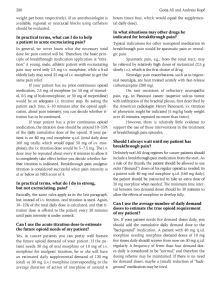Page 292 Guide to Pain Management in Low-Resource Settings
P. 292
280 Gona Ali and Andreas Kopf
weight per hour, respectively). If an anesthesiologist is hours times four, which would equal the supplemen-
available, regional or neuraxial blocks using catheters tal daily dose).
should be evaluated.
In what situations may other drugs be
In practical terms, what can I do to help indicated for breakthrough pain?
a patient in acute excruciating pain? Typical indications for other nonopioid medication in
In general, we never know what the necessary total breakthrough pain would be spasmatic pain or neural-
dose for pain control will be. Th erefore, the basic prin- gic pain.
ciple of breakthrough medication application is “titra- Spasmatic pain, e.g., from the renal tract, may
tion.” A young, male, athletic patient with excruciating be relieved by relatively high doses of metamizol (2.5 g
pain may need only 2.5 mg i.v. morphine, while a frail slowly i.v.), which is the fi rst choice of drug.
elderly lady may need 25 mg of i.v. morphine to get the Neuralgic pain exacerbations, such as in trigem-
same pain relief. inal neuralgia, are best treated acutely with fast-release
If your patient has no prior continuous opioid carbamazepine (200 mg).
medication, 2.5 mg of morphine (or 50 mg of tramad- On rare occasions of refractory neuropathic
ol, 0.5 mg of hydromorphone, or 50 mg of meperidine) pain, e.g., in Pancoast cancer (superior sulcus tumor
would be an adequate i.v. titration step. By asking the with infi ltration of the brachial plexus, fi rst described by
patient each time, 5–10 minutes after the opioid appli- the American radiologist Henry Pancoast), i.v. titration
cation, about pain intensity, you can decide whether ti- of phenytoin might be indicated (5 mg/kg body weight
tration has to be continued. over 45 minutes, repeated no more than twice).
If your patient has a prior continuous opioid However, there is relatively little evidence to
medication, the titration dose should be around 10–15% support the use of these interventions in the treatment
of the daily cumulative dose of the opioid. If your pa- of breakthrough pain episodes.
tient is on 40 mg oral morphine q.i.d. (total daily dose
160 mg orally, which would equal 50 mg of i.v. mor- Should I always wait until my patient has
breakthrough pain?
phine), the i.v. titration dose would be 5–7.5 mg. Th e i.v.
dose may be repeated about every 8 minutes to allow it Defi nitely not! All drug regimes for cancer patients should
to completely take eff ect before you decide whether fur- include a breakthrough pain medication from the start. As
ther titration is indicated. Breakthrough pain analgesic a rule of the thumb, the patient should be allowed to use
titration is considered successful when pain intensity is extra (“demand”) doses of his regular opioid as needed. In
at or below an NRS score of 4. a patient with 40 mg oral morphine q.i.d. (160 mg daily),
the patient should be instructed to take an extra dose of
In practical terms, what do I do in strong, 20 mg morphine when needed. Th e minimum time inter-
but not excruciating, pain? val between two demand doses should be 30 minutes to
Basically, the same rules apply as in the last paragraph, allow the eff ects of morphine to develop fully.
but instead of i.v. titration, oral titration is used. Again,
10–15% of the total daily dose is calculated, and that ti- Can I use the average number of daily demand
doses to estimate the true opioid requirement
tration dose is off ered to the patient every 30 minutes
of my patient?
until pain intensity is under control.
Yes. If your patient needs fi ve demand doses daily, you
Can I use the acute titration dose to estimate should add the cumulative daily demand dose to the
the future opioid needs of my patient? “background” medication. A patient with 40 mg q.i.d.
Yes, in cancer patients you can pretty well foresee morphine needing morphine demand doses of 10 mg
the future opioid demand of your patient. If the pa- fi ve times daily should receive from now on 50 mg q.i.d.
tient needs 30 mg of oral morphine or 10 mg of i.v. regularly. A frequency of fewer than four demand dos-
morphine for analgesic titration, he or she will have es daily is considered to be “normal,” and therefore the
an estimated daily supplemental demand of 120 mg dosing scheme may be maintained. If there is no need
(oral) or 30 mg (i.v.) morphine (corresponding to the for demand doses, maybe a (small) reduction of “back-
average duration of action of morphine of around 6 ground” medication may be tried.


